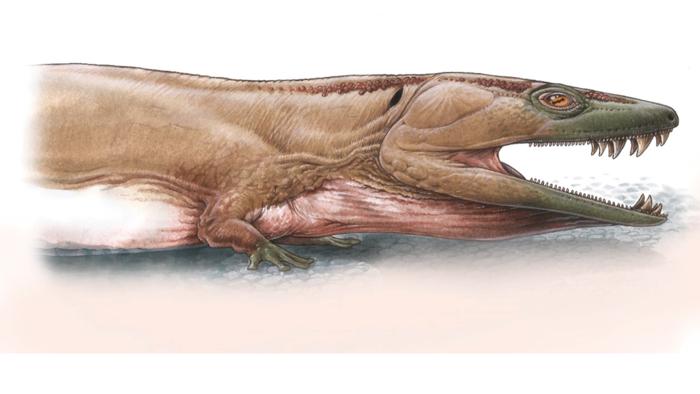Paleontologists have discovered a massive ancient predator in Namibia’s Ugab River valley. The 3-meter-long fossilized skeleton belongs to a new species of early four-legged vertebrate that lived about 280 million years ago. This finding challenges long-held beliefs about where and when these creatures evolved, shifting focus to the southern hemisphere’s role in early animal evolution.
The newly discovered species, named Gaiasia jennyae, was an apex predator in the wetlands of southern Gondwana, the ancient supercontinent that included modern-day Africa, South America, Antarctica, Australia, and India. Its discovery provides crucial insights into how animals transitioned from water to land and spread across the globe.
A Surprising Find in the Namibian Desert
An international team of researchers from South Africa, Namibia, Argentina, and the US made the discovery during a field expedition funded by PAST Africa and the National Geographic Society. They were searching for evidence of early four-legged animals in Gondwana when they stumbled upon something unexpected.
“The nearly complete skeleton was preserved in mudstone from an ancient freshwater lake. As the soft tissue decomposed, gases formed that caused calcium carbonate to crystallise around the bones, creating a hard crust that protected them from being crushed as they were buried deeper,” explains Prof. Roger Smith, Distinguished Professor at the Evolutionary Studies Institute at Wits and Emeritus Research Associate at Iziko Museums, Cape Town.
Sibusiso Mtungata, a fossil technician from the Iziko Museum, recounts the moment of discovery: “We had found isolated vertebrae of something big, so we were looking for a more complete skeleton. I came across two round cylinders of rock with bone in the middle which fitted together – and then a third. I called Roger over to help me find more, and as we walked upslope, he spotted a large flat rock which he recognised as the head. When we looked along the edge and saw rows of teeth, we knew we had finally found what we had been searching for – a nearly complete skull and skeleton!”
Rewriting the Early History of Four-Legged Animals
The fossil’s preparation revealed unique features that set it apart from previously known species. Its large, flattened skull was decorated with unusual patterns and had a distinctive palate structure. Enormous, backward-curved fangs in both the upper and lower jaws created a mouth unlike anything seen before in fossil records.
Prof. Claudia Marsicano from the University of Buenos Aires, Argentina, emphasizes the significance of the find: “As soon as I saw this enormous animal, I knew it was a different species. There is no record of giant basal tetrapods during the Carboniferous-Permian transition (approximately 299 million years ago) anywhere in the world, and certainly none from the southern continents that made up Gondwana. What caught my attention next was the structure of the front part of the skull, which was sticking out of the ground. It showed unusually interlocking large fangs.”
The discovery of Gaiasia jennyae challenges previous assumptions about early tetrapod distribution and evolution. “This discovery challenges previous beliefs about early tetrapod distribution and evolution, which were mostly based on fossils from the northern hemisphere,” says Prof. Marsicano. “Our research shows a well-established early Permian fauna, with Gaiasia as an apex predator, in rocks from high-latitude Gondwana, now located in central Namibia. This challenges previous ideas and proves that the early history of tetrapods in Pangea during the Palaeozoic was much more complex than we thought.”
This groundbreaking discovery not only reshapes our understanding of early animal evolution but also highlights the importance of southern continents in future paleontological research. The specimen will soon be on display at the Geological Museum of Namibia, offering visitors a glimpse into the prehistoric past of southern Africa.


